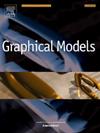FastClothGNN:优化图神经网络中的消息传递,加速实时布料模拟
IF 2.2
4区 计算机科学
Q2 COMPUTER SCIENCE, SOFTWARE ENGINEERING
引用次数: 0
摘要
我们提出了一种高效的消息聚合算法FastClothGNN,用于专门设计用于虚拟试穿系统中实时布料模拟的图神经网络(gnn)。我们的方法通过优化邻居采样和最小化布节点和障碍节点之间不必要的消息传递来减少计算冗余。这大大加快了布料模拟的实时性能,使其成为交互式虚拟环境的理想选择。实验表明,该算法显著提高了gnn的记忆效率,提高了训练和推理的性能。这种优化使我们的算法能够有效地应用于资源受限的环境中,为用户提供更加无缝和沉浸式的交互,从而增加了实际实时应用的潜力。本文章由计算机程序翻译,如有差异,请以英文原文为准。

FastClothGNN: Optimizing message passing in Graph Neural Networks for accelerating real-time cloth simulation
We present an efficient message aggregation algorithm FastClothGNN for Graph Neural Networks (GNNs) specifically designed for real-time cloth simulation in virtual try-on systems. Our approach reduces computational redundancy by optimizing neighbor sampling and minimizing unnecessary message-passing between cloth and obstacle nodes. This significantly accelerates the real-time performance of cloth simulation, making it ideal for interactive virtual environments. Our experiments demonstrate that our algorithm significantly enhances memory efficiency and improve the performance both in training and in inference in GNNs. This optimization enables our algorithm to be effectively applied to resource-constrained, providing users with more seamless and immersive interactions and thereby increasing the potential for practical real-time applications.
求助全文
通过发布文献求助,成功后即可免费获取论文全文。
去求助
来源期刊

Graphical Models
工程技术-计算机:软件工程
CiteScore
3.60
自引率
5.90%
发文量
15
审稿时长
47 days
期刊介绍:
Graphical Models is recognized internationally as a highly rated, top tier journal and is focused on the creation, geometric processing, animation, and visualization of graphical models and on their applications in engineering, science, culture, and entertainment. GMOD provides its readers with thoroughly reviewed and carefully selected papers that disseminate exciting innovations, that teach rigorous theoretical foundations, that propose robust and efficient solutions, or that describe ambitious systems or applications in a variety of topics.
We invite papers in five categories: research (contributions of novel theoretical or practical approaches or solutions), survey (opinionated views of the state-of-the-art and challenges in a specific topic), system (the architecture and implementation details of an innovative architecture for a complete system that supports model/animation design, acquisition, analysis, visualization?), application (description of a novel application of know techniques and evaluation of its impact), or lecture (an elegant and inspiring perspective on previously published results that clarifies them and teaches them in a new way).
GMOD offers its authors an accelerated review, feedback from experts in the field, immediate online publication of accepted papers, no restriction on color and length (when justified by the content) in the online version, and a broad promotion of published papers. A prestigious group of editors selected from among the premier international researchers in their fields oversees the review process.
 求助内容:
求助内容: 应助结果提醒方式:
应助结果提醒方式:


